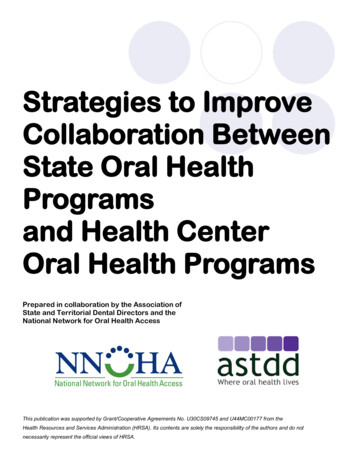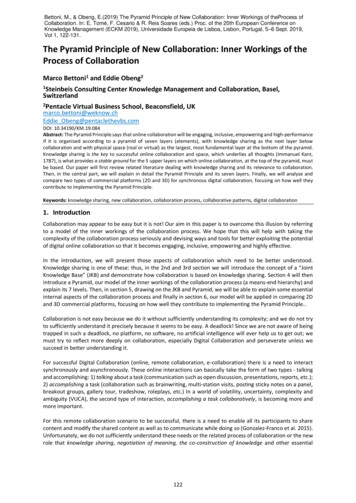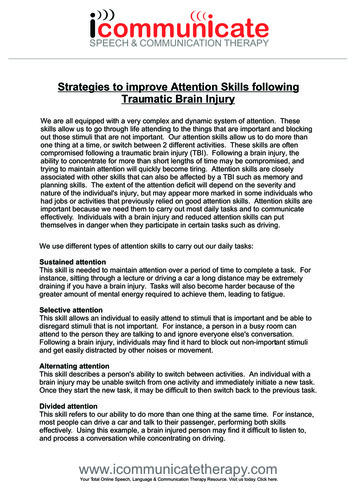
Transcription
Strategies to ImproveCollaboration BetweenState Oral HealthProgramsand Health CenterOral Health ProgramsPrepared in collaboration by the Association ofState and Territorial Dental Directors and theNational Network for Oral Health AccessThis publication was supported by Grant/Cooperative Agreements No. U30CS09745 and U44MC00177 from theHealth Resources and Services Administration (HRSA). Its contents are solely the responsibility of the authors and do notnecessarily represent the official views of HRSA.
Strategies to Improve Collaboration Between State Oral HealthPrograms and Health Center Oral Health ProgramsPurposeMany populations face challenges in accessing oral health services. Limiting factors can include thelack of available providers, restrictive state dental practice acts, scarcity of school-based healthcenters that provide dental services, lack of a regular source of health care (including dental care),lack of health or dental insurance, lack of awareness of the importance of oral health to overallhealth, and certain health beliefs. The extent of the oral health access problem highlights the needto identify new strategies and partnerships to meet the needs of all sectors of the U.S. population.This Issue Brief is intended to help state and territorial oral health programs (SOHPs), Health Centers, funders, policy makers, and other stakeholders recognize and support opportunities for collaboration between SOHPs and Health Centers.Health CentersHealth Centers provide comprehensive primaryhealth care to over 20 million people across thecountry regardless of income or insurance1. HealthCenters are community-based and patient-directedorganizations that serve populations with limitedaccess to health care. Among those served are lowincome populations, the uninsured, those with limited English proficiency, migrant and seasonalfarmworkers, individuals and families experiencinghomelessness, and those living in public housing.Health Centers provide primary health care servicessuch as checkups, immunizations, dental care, prescription drugs, mental health services, and substance abuse treatment.State Oral Health ProgramsSOHPs improve a state’s oral health by raisingawareness of the relationship of oral diseases tosystemic health and by addressing Healthy People2020 Oral Health goals to “prevent and control oraland craniofacial diseases, conditions, and injuries,and improve access to preventive services and dental care.2 SOHP roles include describing and quantifying oral disease, mobilizing and leveragingavailable resources, developing and implementingWhat Is NNOHA?The National Network for Oral Health Access (NNOHA) is anon-profit organization founded in 1990 by a nationwidegroup of Dental Directors from Health Centers that recognized the need for peer-to-peer networking, services, andcollaboration to most effectively operate Health Center oralhealth programs that serve underserved populations. NNOHA has a diverse membership of Health Centeroral health providers: Dental Directors, dental hygienists,and their supporters. NNOHA’s membership represents thediversity of Health Center oral health settings – from noviceto experienced Dental Directors (from 30 days to 30 years)to diverse Health Center settings - from isolated, rural, onedentist clinics, to large urban practices with 20 or more dentists. NNOHA was originally run solely by volunteers, butsince 2007 has been supported in large part by CooperativeAgreement funding from the Health Resources and Services Administration (HRSA).As the only national organization representing Health Center oral health providers, NNOHA is dedicated to improvingaccess to primary oral health care services for disadvantaged populations. NNOHA currently develops practicemanagement resources to aid these programs, coordinatescommunications tools to keep the members connected,hosts an annual conference for members to receive bothclinical and leadership continuing education, hosts an onlinejob bank to help fill Health Center dental vacancies, andcoordinates activities around training and technical assistance. NNOHA supports Health Centers aiming to provide,expand, or improve oral health services.The mission of the National Network for Oral Health Access(NNOHA) is to improve the oral health of underserved populations and contribute to overall health through leadership,advocacy, and support to oral health providers in safety-netsystems.2
policies, and facilitating the intersection of oral health withother health, environmental, and human services programs toassist with community and state health improvement .3 The Association of State and Territorial Dental Directors’ Guidelines forState and Territorial Oral Health Programs describes 10 essentialroles that SOHPs play in promoting oral health in the U.S,grouped within the three core public health functions:What is ASTDD?The Association of State and TerritorialDental Directors (ASTDD) is a national non-profit organization representing the directors and staff of state public health agencyprograms for oral health. ASTDD formulates and promotes the establishment ofnational dental public health policy, assistsstate dental programs in the developmentand implementation of programs and policies for the prevention of oral diseases;builds awareness and strengthens dentalpublic health professionals' knowledge andskills by developing position papers andpolicy statements; provides information onoral health to health officials and policymakers, and conducts conferences for thedental public health community.The ASTDD Membership consists of thechief dental public health officer (state dental director) of the state health departmentor equivalent agency, and the U. S. Territories. ASTDD also offers an AssociateMembership, open to any public agency,voluntary organization, tribal entity and/orhealth professionals employed or interested in dental public health.10 Essential Roles that State Oral Health Programs Play in Promoting Oral Health in the U.S.Assessment1. Assess oral health status and implement an oral health surveillance system2. Analyze determinants of oral health and respond to health hazards in the community3. Assess public perceptions about oral health issues and educate/empower them to achieve and maintain optimal oral healthPolicy Development4. Mobilize community partners to leverage resources and advocate for/act on oral health issues5. Develop and implement policies and systematic plans that support state and community oral health effortsAssurance6. Review, educate about and enforce laws and regulations that promote oral health and ensure safe oral health practices7. Reduce barriers to care and assure utilization of personal and population-based oral health services8. Assure an adequate and competent public and private oral health workforce9. Evaluate effectiveness, accessibility and quality of personal and population-based oral health promotion activities and oralhealth services10. Conduct and review research for new insights and innovative solutions to oral health problems.3
Benefits of State Oral Health Program and Health CenterCollaborationSOHPs and Health Center oral health programs share amission to improve the oral health of their communities.Both entities work on common goals in similar arenas andbenefit from strong state and federal oral health policiesand funding. Some states report collaborative relationships between SOHPs, Primary Care Associations, and thestaff of Health Center oral health programs. Joint activitiesinclude participation in state oral health coalitions, oral health summits and governmental taskforces, and drafting of state oral health plans. Primary Care Associations and SOHPs work togetheron mutually beneficial legislative initiatives such as Medicaid funding and changes to state dentalpractice acts. In some states, SOHPs secure federal grant funds to support programs administeredby Primary Care Associations or individual Health Centers. Programs vary from to state, but commonly involve activities designed to strengthen the dental professional workforce and communitybased oral health interventions.The benefits of SOHP and Health Center collaboration include leveraging and sharing financial andprogrammatic resources, cross utilization of public health and clinical professional expertise, andthe ability to maximize political capitol to prioritize oral health issues and develop a strong voicefor oral health on the state level.Examples of CollaborationThe following examples highlight innovative and successful collaborations taking place in somestates. This brief is not a comprehensive list of all activities in all states, but instead focuses on thetypes of projects that can be done utilizing the skills and resources associated with SOHPs, PrimaryCare Associations and Health Centers.The sufficiency of the dental professional workforce to meet the burden of oral disease is a longstanding issue for both SOHPs and Health Center dental clinics. Arkansas, Kansas and New MexicoSOHPs utilize HRSA Workforce Development Grants to aid safety-net clinics in dental staff recruitment and retention. Arkansas and Kansas are without an in-state dental school, so both fund recruitment visits to out-of-state dental schools and offer financial incentives to dentists and dentalhygienists to work in underserved areas, including Health Center dental clinics. Arkansas offers a 10,000 signing bonus to dentists who can commit towork in a Health Center for two years. Kansas developeda dental specific state loan re-payment program for dental professionals who are not eligible for national or statere-payment programs.Health Center dental clinics provide clinical rotations todental professional students in programs facilitated by theSOHPs and the federal SEARCH (Student/Resident Experiences and Rotations in Community Health) program.4
When Alabama’s federal funding for SEARCH was eliminated, a pediatric dentist at the University ofAlabama at Birmingham School of Dentistry on contract to the SOHP picked up the program. Kansas’ SOHP provides their Primary Care Association with funding (in addition to the SEARCH fundsthey receive) for living expenses so more dental and dental hy-“Collaborationsbetween SOHPs,Primary CareAssociations andHealth Centers areexcellent ways toaddress state andcommunity oralhealth issues,especially amongunderservedpopulations.”giene students can have a clinical experience working in rural partsof Kansas. A past program in Colorado used the Migrant HealthProgram (housed in the state health department) to place dentalprofessional students in schools and Health Centers to provide services across the state. This specific program no longer exists, butit forged a strong relationship between the Health Centers and theSOHP. The current Colorado Dental Director attends quarterlyHealth Center meetings to provide dental clinic staff with oralhealth data, policy updates and state loan re-payment assistance.Some states collaborate to provide Health Center dental clinicianswith clinical and administrative support. In New Mexico, the SOHPand Primary Care Association created the New Mexico Dental Sup-port Network Forum, an online support network that providestraining and technical assistance for rural and Community HealthCenter providers. The group also conducts face-to-face meetingsand offers continuing education opportunities. In Illinois, the Department of Public Health (IDPH)Division of Oral Health collaborated with the Illinois Primary Health Care Association to develop theOral Health Network. This network provides technical assistance, training, education, and advocacyto help build and sustain the oral health programs. The Iowa Primary Care Association utilizes theirState Dental Director’s experience with Health Centers to provide individualized technical assistance through clinic site visits and training for Health Center Dental Directors. He is also designinga Peer Review plan that will work within a new electronic health record system.SOHPs and Health Centers often work together to provide community-based oral health programs.In Oregon, the SOHP contracts with dental providers in Health Centers like La Clinica del Cariño toadminister school based sealant programs. In New York, Hudson RiverHealth Care receives state funding for a sealant and a weekly fluoriderinse program in elementary schools. El Rio Community Health CenterDental Department in Tucson, Arizona uses state funds through thePima County Health Department Women, Infants, and Children (WIC)program for First Things First –First Smiles Matter, an early childhoodcaries prevention program.Other joint projects for SOHPs and Health Center dental clinicians aredrafting resource guides, clinic manuals, and oral health research. TheOhio Safety Net Dental Clinics is a comprehensive online portal to thetools and information necessary to start and maintain the operationsand delivery of health care services in safety net dental clinics in Ohio.4SOHP and Health Center staff served on the Advisory Committee for a5
national resource manual, the Safety Net Dental Clinic Manual.5 SOHPs have worked with HealthCenters to conduct oral health surveys on their patient populations and to complete the state’s Basic Screening Survey, a nationally utilized children’s oral health survey. At least one state/HealthCenter collaborative program has been the topic of a research paper on service delivery in underserved populations6.SummaryCollaborations between SOHPs, Primary Care Associations and Health Centers are excellent ways toaddress state and community oral health issues, especially among underserved populations. Thestarting point for many of these collaborations is a strong relationship between the SOHP and thestate’s Primary Care Office (PCO). PCOs, like the SOHP, are often located within State Departmentsof Health. Health Centers are usually familiar with the PCO as they often administer federal andstate clinic grants and student loan re-payment programs. The state Primary Care Association canalso facilitate partnerships between Health Centers and SOHPs. SOHP staff can connect with HealthCenter dental clinicians thorough their state’s Primary Care Association conferences and by joiningNNOHA. Health Centers that are looking for assistance in implementing community based programs, developing state oral health policy, or interested in other types of collaborations should investigate the resources available through their SOHP and ASTDD. The examples described in thisissue brief make it clear that there is much to be gained by working together.NNOHA Key Resources National Network for Oral Health Access Website: http://www.nnoha.org/ The National Primary Oral Health Conference is an annual conference geared towards Health Center oral health ml Online resources for providers include a quarterly newsletter, white papers, a literature review, and a dental forms library: http://www.nnoha.org/resources.html An on-line job bank is available to help fill Health Center dental vacancies: http://www.nnoha.org/dentalcareers.html An online discussion forum is available for people involved in Health Center oral health programs wanting to have discussionswith their peers: http://www.nnoha.org/forums.html For more information on Health Centers, please visit http://bphc.hrsa.gov/about/ASTDD Key Resources ASTDD’s website: http://www.astdd.org/ The National Oral Health Conference, the nation's premier dental public health conference: http://www.nationaloralhealthconference.com/ Guidelines for State and Territorial Oral Health Programs , a resource to assist health agency officials and public health administrators develop and operate strong oral health programs: http://www.astdd.org/state-guidelines/ Competencies for State Oral Health Programs, the skill sets needed for a successful state oral health program: StateOralHealthProgramsfinal.pdf Proven and promising best practices for state oral health programs: http://www.astdd.org/best-practices/References1. About NACHC: http://nachc.org/about-nachc.cfm2.Healthy People 2020 Topics and Objectives – Oral Health 2020/overview.aspx?topicid 323. ASTDD. Guidelines for State and Territorial Oral Health Programs: http://www.astdd.org/state-guidelines/4. Ohio Safety Net Dental Clinics, http://www.ohiodentalclinics.com/5. Safety Net Dental Clinic Manual, http://dentalclinicmanual.com/6. http://muse.jhu.edu/login?uri /journals/journal of health care for the poor and underserved/v013/13.1.zabos.pdf6
policy statements; provides information on oral health to health officials and policy makers, and conducts conferences for the dental public health community. The ASTDD Membership consists of the chief dental public health officer (state den-tal director) of the state health department or equivalent agency, and the U. S. Territo-ries.











